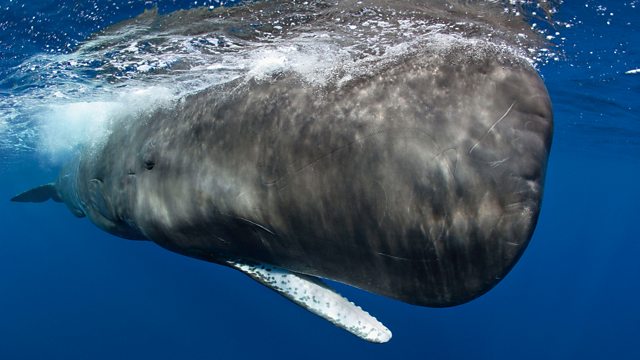Ocean Giants episode 3 – Voices of the Sea: Whales and dolphins are nature’s supreme vocalists, with a repertoire to put an opera singer to shame. The mighty sperm whale produces deafening clicks in its blowhole which it uses to locate giant squid two miles down in the ocean abyss, while migrating narwhals use similar sounds to pinpoint vital breathing holes in Arctic ice floes.
The pink boto dolphin creates bat-like ultrasonic clicks to ‘see with sound’ and to catch fish in the murky waters of the Amazon River, and also uses whistles and chirps for social conversations.
Killer whales in the North Sea use wolf-like howls to round up the herring shoals which they feed on, and they and other dolphins also use percussive tail slaps and splashing leaps to signal to each other. One group of bottlenose dolphins in Brazil has even learned to communicate with fishermen in a unique partnership.
But the most famous and mysterious voice of all surely belongs to male humpback whales, whose haunting operatic performances may last several hours and seem to be about singing purely for the sheer pleasure of making music.
Ocean Giants episode 3 – Voices of the Sea
Sperm whale
The sperm whale is the largest of the toothed whales and the largest toothed predator. It is the only living member of the genus Physeter and one of three extant species in the sperm whale family, along with the pygmy sperm whale and dwarf sperm whale of the genus Kogia.
The sperm whale is a pelagic mammal with a worldwide range, and will migrate seasonally for feeding and breeding. Females and young males live together in groups, while mature males (bulls) live solitary lives outside of the mating season. The females cooperate to protect and nurse their young. Females give birth every four to twenty years, and care for the calves for more than a decade. A mature sperm whale has few natural predators, although calves and weakened adults are sometimes killed by pods of killer whales (orcas).
Mature males average 16 metres (52 ft) in length but some may reach 20.7 metres (68 ft), with the head representing up to one-third of the animal’s length. Plunging to 2,250 metres (7,382 ft), it is the third deepest diving mammal, exceeded only by the southern elephant seal and Cuvier’s beaked whale. The sperm whale uses echolocation and vocalization as loud as 230 decibels (re 1 µPa m) underwater. It has the largest brain on Earth, more than five times heavier than a human’s. Sperm whales can live 70 years or more.
Narwhal
The narwhal or narwhale (Monodon monoceros) is a medium-sized toothed whale that possesses a large “tusk” from a protruding canine tooth. It lives year-round in the Arctic waters around Greenland, Canada, and Russia. It is one of two living species of whale in the family Monodontidae, along with the beluga whale. The narwhal males are distinguished by a long, straight, helical tusk, which is an elongated upper left canine. The narwhal was one of many species described by Carl Linnaeus in his publication Systema Naturae in 1758.
Like the beluga, narwhals are medium-sized whales. For both sexes, excluding the male’s tusk, the total body size can range from 3.95 to 5.5 m (13 to 18 ft); the males are slightly larger than the females. The average weight of an adult narwhal is 800 to 1,600 kg (1,760 to 3,530 lb). At around 11 to 13 years old, the males become sexually mature; females become sexually mature at about 5 to 8 years old. Narwhals do not have a dorsal fin, and their neck vertebrae are jointed like those of most other mammals, not fused as in dolphins and most whales.
Found primarily in Canadian Arctic and Greenlandic and Russian waters, the narwhal is a uniquely specialized Arctic predator. In winter, it feeds on benthic prey, mostly flatfish, under dense pack ice. During the summer, narwhals eat mostly Arctic cod and Greenland halibut, with other fish such as polar cod making up the remainder of their diet. Each year, they migrate from bays into the ocean as summer comes. In the winter, the male narwhals occasionally dive up to 1,500 m (4,920 ft) in depth, with dives lasting up to 25 minutes. Narwhals, like most toothed whales, communicate with “clicks”, “whistles”, and “knocks”.




